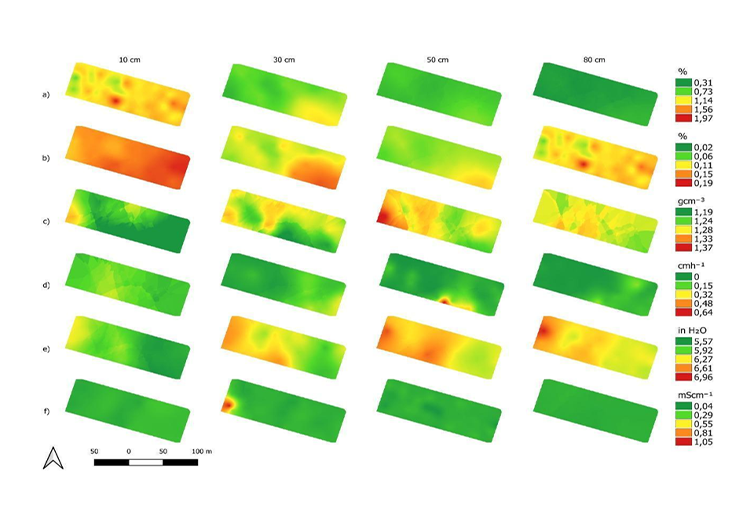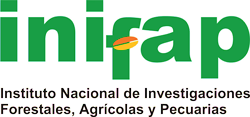Carbon variability in the soil of a rice field in Costa Rica
DOI:
https://doi.org/10.29312/remexca.v16i5.3664Keywords:
climate change mitigation, geostatistical interpolation, kriging method, soil mappingAbstract
Knowledge of the soil carbon stock (SCS) is vital for appropriate farming practices management, ie. tillage and to monitor SCS changes as mitigation strategies of carbon footprint. This study aims to quantify the variability and spatial distribution of the SCS. In an area of 1 ha 45 micro-pit (1 x 0.8 x 1 m) were divided into four strata. Vertical distribution of soil carbon was quantified along with other chemical and physical soil properties that affect rice production in Parrita, Costa Rica. A map of spatial prediction of the distribution and goodness-of-prediction values were calculated to estimate the effectiveness of the SCS prediction when different numbers of sampling points were used 45, 27, 15 and 7 microplots. As accurate measurements, the Mean Absolute Error and the Mean Square Error were calculated. In this study, the SCS was 85.8 (±2.6) Mg C ha-1, into the total profile (0-100 cm), where the first 30 cm represented 46.2%. Prediction of the spatial distribution suggests that in annual agricultural crops, with tillage systems 15 sampling points ha-1 a can effectively estimate the SCS.
Downloads
References
Aguilera, E.; Lassaletta, L.; Gattinger, A. and Gimeno, B. S. 2013. Managing soil carbon for climate change mitigation and adaptation in mediterranean cropping systems: a meta-analysis. Agriculture, Ecosystems and Environment. 168:25-36. https://doi.org/10.1016/j.agee.2013.02.003.
Ahmed, I. S.; Hassan, F. A.; Sulieman, M. M.; Keshavarzi, A.; Elmobarak, A. A.; Yousif, K. M. and Brevik, E. C. 2022. Using environmental covariates to predict soil organic carbon stocks in Vertisols of Sudan. Geoderma Regional. 31(e00578):1-16. https://doi.org/10.1016/j.geodrs.2022.e00578.
Alvarado-Velas, M.; Monge-Cordero, M.; Arias-Fernández, M.; Chinchilla-Cortés, J.; Briones-Cambronero, K.; and Alfaro-Martínez, A. 2021. Estudio hidrogeológico de los acuíferos del Pacífico Central, provincias de Puntarenas y San José, Costa Rica, América Central (Informe técnico). Dirección de Investigación y Gestión Hídrica, Unidad de Investigación Hidrogeológica. SENARA. 12-246 pp.
Anantha, K. C.; Majumder, S. P.; Padhan, D.; Badole, S.; Datta, A.; Mandal, B. and Gade, K. R. 2018. Carbon dynamics, potential and cost of carbon sequestration in double rice cropping system in semiarid southern India. Journal of Soil Science and Plant Nutrition. 18(2):418-434. https://doi.org/10.4067/S0718-95162018005001302.
Augustin, C. and Cihacek, L. J. 2016. relationships between soil carbon and soil texture in the northern great plains. Soil Science. 181(8):386-392. Doi: https://doi.org/10.1097/SS.0000000000000173.
Averill, C. and Waring, B. 2018. Nitrogen limitation of decomposition and decay: How can it occur?. Global Change Biology. 24(4):1417-1427. https://doi.org/10.1111/gcb.13980.
Bhunia, G. S.; Shit, P. K. and Maiti, R. 2018. Comparison of GIS-based interpolation methods for spatial distribution of soil organic carbon (SOC). Journal of the Saudi Society of Agricultural Sciences. 17(2):114-126. https://doi.org/10.1016/j.jssas.2016.02.001.
Bogunovic, I.; Kisic, I.; Mesic, M.; Percin, A.; Zgorelec, Z.; Bilandžija, D.; Jonjic, A. and Pereira, P. 2017. Reducing sampling intensity in order to investigate spatial variability of soil pH, organic matter and available phosphorus using co-kriging techniques. A case study of acid soils in Eastern Croatia. Archives of Agronomy and Soil Science. 63(13):1852-1863. https://doi.org/10.1080/03650340.2017.1311013.
Börjesson, G.; Bolinder, M. A.; Kirchmann, H. and Kätterer, T. 2018. Organic carbon stocks in topsoil and subsoil in long-term ley and cereal monoculture rotations. Biology and Fertility of Soils. 54(4):549-558. https://doi.org/10.1007/s00374-018-1281-x.
Chacón, P.; Lorenz, K.; Lal, R.; Calhoun, F. G. and Fausey, N. 2015. Soil organic carbon in some land uses of Costa Rica. Acta Agriculturae Scandinavica Section B: soil and Plant Science. 65(4):310-320. https://doi.org/10.1080/09064710.2015.1008563.
Chatterjee, N.; Nair, P. K.; Nair, V. D.; Bhattacharjeem, A.; Virginio-Filho, E. M.; Muschler, R. G. and Noponen, M. R. A. 2020. Do coffee agroforestry systems always improve soil carbon stocks deeper in the soil? a case study from Turrialba, Costa Rica. Forests. 11(1):1-49. https://doi.org/10.3390/f11010049.
Chen, X.; Hu, Y.; Xia, Y.; Zheng, S. ; Ma, C.; Rui, Y.; He, H.; Huang, D.; Zhang, Z.; Ge, T.; Wu, J.; Guggenberger, G.; Kuzyakov, Y. and Su, Y. 2021. Contrasting pathways of carbon sequestration in paddy and upland soils. Global Change Biology. 27(11):2478-2490. https://doi.org/10.1111/gcb.15595.
Davis, M.; Alves, B. J.; Karlen, D. L.; Kline, K. L.; Galdos, M. and Abulebdeh, D. 2018. Review of soil organic carbon measurement protocols: a US and Brazil comparison and recommendation. Sustainability. 10(1):1-20. https://doi.org/10.3390/su10010053.
FAO. 2019. Food and Agriculture Organization of the United Nations. Recarbonization of global soils. A dynamic response to offset global emissions. http://www.fao.org/3/i7235en/I7235EN.pdf. 1-8 pp.
FAO. 2020. Food and Agriculture Organization of the United Nations. A protocol for measurement, monitoring, reporting and verification of soil organic carbon in agricultural landscapes GSOC-MRV Protocol. Rome. https://doi.org/10.4060/cb0509en.
FAO. 2022. Food and Agriculture Organization of the United Nations. Global Soil Organic Carbon Sequestration Potential Map GSOCseq v.1.1. Technical report. Rome. https://doi.org/10.4060/cb9002en.
FAO. 2024. Food and Agriculture Organization of the United Nations. Cómo la iniciativa RECSOIL impulsa el cambio en Costa Rica. FAO Global Soil Partnership. https://www.fao.org/global-soil-partnership/resources/highlights/detail/es/c/1680245/.
Gregory, A. S.; Dungait, J. A. J.; Watts, C. W.; Bol, R.; Dixon, E. R.; White, R. P. and Whitmore, A. P. 2016. Long-term management changes topsoil and subsoil organic carbon and nitrogen dynamics in a temperate agricultural system. European Journal of Soil Science. 67(4):421-430. https://doi.org/10.1111/ejss.12359.
Jandl, R.; Rodeghiero, M.; Martinez, C.; Cotrufo, M. F.; Bampa, F.; Wesemael, B.; Harrison, R. B.; Guerrini, I. A.; Richter, D. D.; Rustad, L.; Lorenz, K.; Chabbi, A. and Miglietta, F. 2014. Current status, uncertainty and future needs in soil organic carbon monitoring. Science of the Total Environment. 468-469:376-383 pp. Doi:10.1016/j.scitotenv.2013.08.026.
Lal, R. 2016. Beyond COP21: potential and challenges of the ‘4 per Thousand’ initiative. Journal of Soil and Water Conservation. 71. 20A-25A pp. https://doi.org/10.2489/jswc.71.1.20A.
Lawrence, P. G.; Roper, W.; Morris, T. F. and Guillard, K. 2020. Guiding soil sampling strategies using classical and spatial statistics: a review. Agronomy Journal. 112(1):493-510. https://doi.org/10.1002/agj2.20048.
Li, C.; Wang, G.; Han, Q.; Sun, J.; Ning, H. and Feng, D. 2023. Soil moisture and water-nitrogen synergy dominate the change of soil carbon stock in farmland. Agricultural Water Management. 287(1):108-424. https://doi.org/10.1016/j.agwat.2023.108424.
Li, Q.; Li, A.; Dai, T.; Fan, Z.; Luo, Y.; Li, S.; Yuan, D.; Zhao, B.; Tao, Q.; Wang, C.; Li, B.; Gao, X.; Li, Y.; Li, H. and Wilson, J. P. 2020. Depth-dependent soil organic carbon dynamics of croplands across the Chengdu plain of China from the 1980s to the 2010s. Global Change Biology. 26(7):4134-4146. https://doi.org/10.1111/gcb.15110.
Matus, F. J. 2021.Fine silt and clay content is the main factor defining maximal C and N accumulations in soils: a meta-analysis. Sci. Rep. 11(6438):1-17. https://doi.org/10.1038/s41598-021-84821-6.
Nayak, A. K.; Rahman, M. M.; Naidu, R.; Dhal, B.; Swain, C. K.; Nayak, A. D.; Tripathi, R.; Shahid, M.; Islam, M. R. and Pathak, H. 2019. Current and emerging methodologies for estimating carbon sequestration in agricultural soils: a review. Science of the Total Environment. 665:890-912. https://doi.org/10.1016/j.scitotenv.2019.02.125.
Oliveira, D. D.; Paustian, K.; Davies, C. A.; Cherubin, M. R.; Franco, A. L.; Cerri, C. C. and Cerri, C. E. 2016. Soil carbon changes in areas undergoing expansion of sugarcane into pastures in south-central Brazil. Agriculture, Ecosystems and Environment. 228:38-48. https://doi.org/10.1016/j.agee.2016.05.005.
Ojeda, J. J.; Caviglia, O. P. and Agnusdei, M. G. 2018. Vertical distribution of root biomass and soil carbon stocks in forage cropping systems. Plant and Soil. 423(1-2):175-191. https://doi.org/10.1007/s11104-017-3502-8.
RStudio Team. 2020. RStudio: integrated development environment for R (Version 1.3.1093) [Computer software]. RStudio, PBC. https://www.rstudio.com/.
Sherman, L. A. and Brye, K. R. 2019. Soil chemical property changes in response to long‐term pineapple cultivation in Costa Rica. Agrosystems, Geosciences and Environment. 2(1):1-9. https://doi.org/10.2134/age2019.07.0052.
Schloeder, C. A.; Zimmerman, N. E. and Jacobs, M. J. 2001. Comparison of methods for interpolating soil properties using limited data. Soil Science Society of America Journal. 65(2):470-479. https://doi.org/10.2136/sssaj2001.652470x.
Smith, P.; Soussana, J.; Angers, D.; Schipper, L.; Chenu, C.; Rasse, D. P.; Batjes, N. H.; Egmond, F.; McNeill, S.; Kuhnert, M.; Arias‐Navarro, C.; Olesen, J. E.; Chirinda, N.; Fornara, D.; Wollenberg, E.; Álvaro‐Fuentes, J.; Sanz‐Cobena, A. and Klumpp, K. 2020. How to measure, report and verify soil carbon change to realize the potential of soil carbon sequestration for atmospheric greenhouse gas removal. Global Change Biology. 26(1):219-241. https://doi.org/10.1111/gcb.14815
Tautges, N. E.; Chiartas, J. L.; Gaudin, A. C. M.; O’Geen, A. T.; Herrera, I. and Scow, K. M. 2019. Deep soil inventories reveal that impacts of cover crops and compost on soil carbon sequestration differ in surface and subsurface soils. Global Change Biology. 25(11):3753-3766. https://doi.org/10.1111/gcb.14762.
Usowicz, B. and Lipiec, J. 2021. Spatial variability of saturated hydraulic conductivity and its linkswith other soil properties at the regional scale. Scientific Reports. 11(1):1-12.https://doi.org/10.1038/s41598-021-86862-3.
Valderrama-López, C. F.; Castillo-Vargas, J. A.; Torres-Romero, J. C.; Guzmán-Lenis, A. R.; Forero-Ausique, V. F.; Duque-Chaves, C. M.; Sepúlveda-Casadiego, Y. A.; Montenegro-Gómez, S. P. 2018. Capítulo 6. Secuestro y almacenamiento de carbono: capturas de carbono por pagos de servicios ambientales. Escuela de Ciencias Agrícolas, Pecuarias y del Medio Ambiente. Universidad Nacional Abierta y a Distancia. 106-117 pp.
Wen, W.; Wang, Y.; Yang, L.; Liang, D.; Chen, L. D.; Liu, J. and Zhu, A. X. 2015. Mapping soil organic carbon using auxiliary environmental covariates in a typical watershed in the loess plateau of China: a comparative study based on three kriging methods and a soil land inference model (SoLIM). Environ Earth Sci. 73:239-251. https://doi.org/10.1007/s12665-014-3518-9.
Wu, H.; Zheng, X. Zhou, L. and Meng, Y. 2024. Spatial autocorrelation and driving factors of carbon emission density of crop production in China. Environ Sci Pollut Res. 31:27172-27191. https://doi.org/10.1007/s11356-024-32908-8.
Xu, S. Q.; Zhang, M. Y.; Zhang, H. L.; Chen, F.; Yang, G. L. and Xiao, X. P. 2013. Soil organic carbon stocks as affected by tillage systems in a double-cropped rice field. Pedosphere. 23(5):696-704. https://doi.org/10.1016/S1002-0160(13)60062-4.
Yu, H.; Zha, T.; Zhang, X. and Ma, L. 2019. Vertical distribution and influencing factors of soil organic carbon in the loess plateau, China. Science of The Total Environment. 693:133632. https://doi.org/10.1016/j.scitotenv.2019.133632.
Zhong, Z.; Chen, Z.; Xu, Y.; Ren, C.; Yang, G.; Han, X.; Ren, G. and Feng, Y. 2018. Relationship between soil organic carbon stocks and clay content under different climatic conditions in Central China. Forests. 9(10):1-14. https://doi.org/10.3390/f9100598.
Zomer, R. J.; Bossio, D. A.; Sommer, R. and Verchot, L. V. 2017. Global sequestration potential of increased organic carbon in cropland soils. Scientific Reports. 7(15554):1-8. https://doi.org/10.1038/s41598-017-15794-8.

Published
How to Cite
Issue
Section
License
Copyright (c) 2025 Revista Mexicana de Ciencias Agrícolas

This work is licensed under a Creative Commons Attribution-NonCommercial 4.0 International License.
The authors who publish in Revista Mexicana de Ciencias Agrícolas accept the following conditions:
In accordance with copyright laws, Revista Mexicana de Ciencias Agrícolas recognizes and respects the authors’ moral right and ownership of property rights which will be transferred to the journal for dissemination in open access. Invariably, all the authors have to sign a letter of transfer of property rights and of originality of the article to Instituto Nacional de Investigaciones Forestales, Agrícolas y Pecuarias (INIFAP) [National Institute of Forestry, Agricultural and Livestock Research]. The author(s) must pay a fee for the reception of articles before proceeding to editorial review.
All the texts published by Revista Mexicana de Ciencias Agrícolas —with no exception— are distributed under a Creative Commons License Attribution-NonCommercial 4.0 International (CC BY-NC 4.0), which allows third parties to use the publication as long as the work’s authorship and its first publication in this journal are mentioned.
The author(s) can enter into independent and additional contractual agreements for the nonexclusive distribution of the version of the article published in Revista Mexicana de Ciencias Agrícolas (for example include it into an institutional repository or publish it in a book) as long as it is clearly and explicitly indicated that the work was published for the first time in Revista Mexicana de Ciencias Agrícolas.
For all the above, the authors shall send the Letter-transfer of Property Rights for the first publication duly filled in and signed by the author(s). This form must be sent as a PDF file to: revista_atm@yahoo.com.mx; cienciasagricola@inifap.gob.mx; remexca2017@gmail.
This work is licensed under a Creative Commons Attribution-Noncommercial 4.0 International license.


